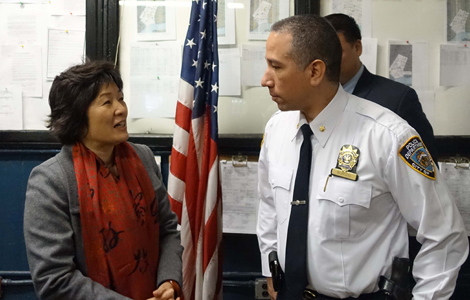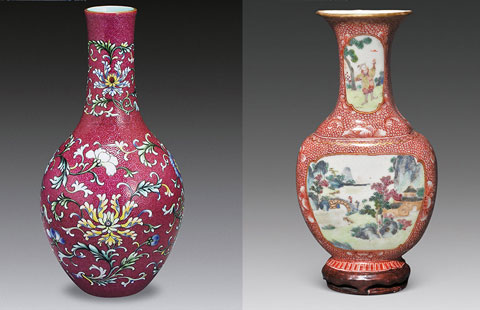Crossing the street is a different experience in China, US
Updated: 2014-12-02 11:33
By Chen Weihua(China Daily USA)
|
||||||||
For Chinese coming to the United States, crossing streets and driving on highways in American cities is much less of a hair-raising experience.

In US cities, such as New York and Washington, drivers almost always yield to pedestrians crossing the street. While some drivers may like to cut in and bob and weave to get ahead in busy traffic, most American drivers are much more patient than their Chinese counterparts.
However, in Shanghai, the largest Chinese metropolis, pedestrians always have to look around for turning vehicles when crossing streets to avoid getting run over. Many drivers simply don't yield to pedestrians. On the city's Inner Ring Road, which encircles downtown Shanghai, drivers often turn the few lanes into a race track with constant cut-ins and lane changes.
Failure to improve traffic safety and manners over the years has long been a source of public complaint in China, especially as there are more cars put onto the roads every year. It's much more common to see road rage in China than in the US.
On Tuesday, Dec 2, China's Ministry of Public Security will carry out a nationwide crackdown on major traffic violations, including speeding, overloading, driving under the influence of alcohol or drugs, running red lights, driving on shoulders and failure to yield to pedestrians at crossings.
Ministry officials say these infractions account for a quarter of the total traffic violations in China. It will be the third year since National Traffic Safety Day was launched two years ago to raise public awareness of road safety after China's roads have become some of the deadliest in the world.
For most years starting in 2001, the annual death toll from traffic accidents in China hovered around 100,000, meaning that an average of some 270 people were killed on the roads every day.
However, that figure has started to drop in recent years thanks to improvements in infrastructure, traffic control and public awareness. The death toll from traffic accidents in 2012 plunged to 60,000, compared to 104,000 in 2003, Gao Hongfeng, vice-minister of transport, told Xinhua News Agency.
Though the Ministry of Public Security has not yet announced the total roadway death toll numbers for 2013, it has described a much improved picture over previous years. Indices that measure the number of traffic accidents, the number of people injured in traffic accidents, the number of deaths and resulting economic losses were all on the decline in 2013.
Separate reports showed that the death toll from traffic accidents declined by 13.3 percent in 2013 from the previous year, which would translate into a death toll of some 52,000.
That compares to the estimated 35,200 traffic deaths reported in the US in 2013, the National Safety Council was quoted in the Christian Science Monitor.
A report by the University of Michigan Transportation Research Institute released in February this year showed that the fatality rate per 100,000 population from road crashes in China was 22, ranking China 44th in the world in fatality rates. The world average is 18.
The US, ranked 97th, had a fatality rate of 14 per 100,000 people, according to the report based on World Health Organization data from 2008.
The highest rate among the 183 countries was Namibia, with 45 per 100,000 people, while the lowest was the Maldives at 2 per 100,000.
Namibia, Thailand, Iran, Sudan, Swaziland, Venezuela, Congo, Malawi, the Dominican Republic and Iraq were also high on the fatality rate, while the lowest-rate countries also include Tajikistan, Malta, Fiji, the Marshall Islands, Israel, Antigua, Barbuda, the Netherlands and Switzerland.
There is no doubt that with the latest data, the fatality rate in China would have come down since the overall death toll from traffic accidents has declined. It would mean great progress, considering the number of cars in the country reached 137 million by the end of 2013, about 5.7 times the 2003 figure. In 2013 alone, some 16.51 million cars were added to the streets and 17.9 million new drivers were added to the pool, according to the Ministry of Public Security.
China has already become the world's largest car market, with sales of nearly 22 million vehicles in 2013, compared with 15.6 million units sold in the US.
While China's National Traffic Safety Day on Dec 2 could mean harsh penalties for violators, many Chinese might hope the strict rules would be enforced every day of the year, so that crossing streets and driving on highways will be less of a life-threatening experience.
Contact the writer at chenweihua@chinadailyusa.com.

 Music at her fingers
Music at her fingers
 Across America Over the Week (Jan 16 - Jan 22)
Across America Over the Week (Jan 16 - Jan 22)
 Spend Chinese New Year in style
Spend Chinese New Year in style
 Ili river valley becomes a popular destination for swans
Ili river valley becomes a popular destination for swans
 Philip Ma: from scientist to businessman
Philip Ma: from scientist to businessman
 Birmingham's Spotlight on China dinner
Birmingham's Spotlight on China dinner
 How to distinguish doucai, wucai, Famille-rose and enamel porcelain
How to distinguish doucai, wucai, Famille-rose and enamel porcelain
 Xinjiang lake in bumper fishing season
Xinjiang lake in bumper fishing season
Most Viewed
Editor's Picks

|

|

|

|

|

|
Today's Top News
Houston's SW Chinatown
China to focus on reforms, opening of capital market
Slowdown brings new risks to banks
Trade group calls for BIT
Market status for China is 'political' issue
Birmingham's Spotlight on China dinner
Bank takes renminbi-clearing seriously
Traditional Garb
US Weekly

|

|







